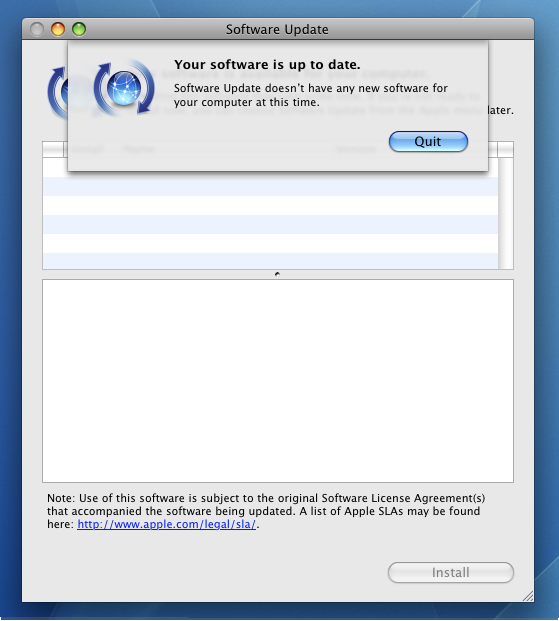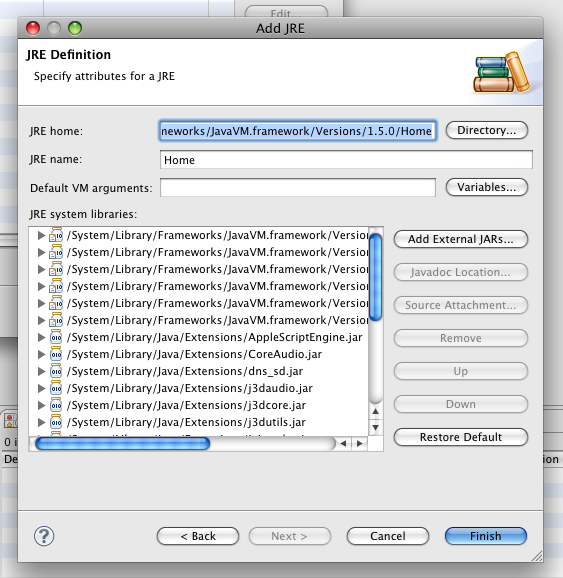Setting up a Java development environment on Mac OS X 10.5 for PowerPC #
Recently I got into my head that I wanted to play around with some retro Java development and relive some of my earliest programming memories for nostalgia reasons. Although the appropriate setup for what I had back in the day was JDK 1.5 running on Windows XP and Netbeans, I decided to go for quite a different, but extremely nostalgic setup of Java 1.5.0 on Mac OS X 10.5 Leopard with Eclipse Juno, mostly because I wanted to spend more time with my Power Mac G5, but also because I was unable to download older versions of Netbeans due to them not being properly archived, which is extremely sad.
The first step towards the goal of a proper Java development experience on this platform is to ensure the bundled version of Java from Apple is completely up-to-date, since we want to have an authentic experience we will be using the bundled Java and not OpenJDK. You can ensure you're on the latest version by checking for software updates using the Software Update tool on Mac OS X 10.5. If there are no updates available you're set!
After that you'll need a period correct IDE to develop on. I choose to use Eclipse Juno 3.8.2 since it was the last version of Eclipse from this era and because Netbeans wasn't available, otherwise I would've used it. You can still download older Eclipse versions from their project archives ( direct link to version 3.8.2). Remember to download the Eclipse SDK archive, which comes with everything for Java development, not just the Eclipse Platform.
After you have Eclipse 3.8.2 downloaded you should extract it and copy its
folder to /Applications where it'll live. After the initial
workspace setup you must select the appropriate JRE for it to use, at least in
my case it wasn't capable of finding it automatically. To do this you must go to
Eclipse > Preferences..., in the preferences window navigate to
Java > Installed JREs and add a new JRE. For the type ensure you
select MacOS X VM to signal that you are using the built-in JRE
from Apple. Now for the JRE home you should select the
/System/Library/Frameworks/JavaVM.framework/Versions/1.5.0/Home
directory, which is where Apple stores their JRE on OS X 10.5. Your window
should look more or less like this after Eclipse finds all the system libraries
included:
Now you should have everything to start developing Java apps on Mac OS X, but if you want to build graphical applications with ease it's always recommended to install Eclipse's WindowBuilder. Since we are unable to automatically install it through their online update sitedue to their insistance in using HTTPS we'll have to download update archives for it and all of its dependencies. In my case I went with WindowBuilder 1.7.0, although while trying to install WindowBuilder I was unable to proceed because of a missing dependency:
Cannot complete the install because one or more required items could not be found.
Software being installed: WindowBuilder XML Core (requires Eclipse WTP/WST) 1.7.0.r37x201405021458 (org.eclipse.wb.core.xml.feature.feature.group 1.7.0.r37x201405021458)
Missing requirement: WindowBuilder Core for XML GUI's 1.7.0.r37x201405021458 (org.eclipse.wb.core.xml 1.7.0.r37x201405021458) requires 'bundle org.eclipse.wst.sse.core 0.0.0' but it could not be found
Cannot satisfy dependency:
From: WindowBuilder Databinding XML Core 1.7.0.r37x201405021458 (org.eclipse.wb.core.databinding.xml 1.7.0.r37x201405021458)
To: bundle org.eclipse.wb.core.xml 0.0.0
Cannot satisfy dependency:
From: WindowBuilder XML Core (requires Eclipse WTP/WST) 1.7.0.r37x201405021458 (org.eclipse.wb.core.xml.feature.feature.group 1.7.0.r37x201405021458)
To: org.eclipse.wb.core.databinding.xml [1.7.0.r37x201405021458]The problem is that when I went to get a copy of the Eclipse Web Tools Platform, in my case the era appropriate version 3.5.2 I realized that their entire archive was missing the actual releases, only the checksum files are available, so I guess someone decided to delete their entire release archive to save space. This is a major problem and unless the archives resurface there's no way to install the WTP on older versions of Eclipse.
Although a bit disappointed, I still have a fully functioning retro Java development environment to play around and to write some amazing retro applications, or just port Java software to older systems. I wish someone could find a way of providing a lasting archive of Eclipse's entire back catalog to keep these older systems alive.

